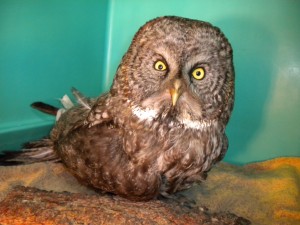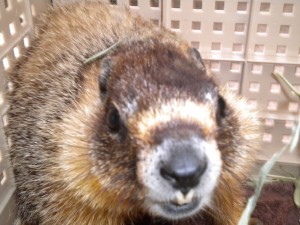Eastern Sierra Wildlife Care press release
FALL AT ESWC: BABIES LEAVING HOME AND WILD SPIRITS ON THE WING
As days grow short, the last birds and mammals of the busy “baby season” are leaving the shelter of Eastern Sierra Wildlife Care and facing the demands of freedom. A late Barn Swallow youngster took wing today into a mixed flock of Violet-Green and Cliff Swallows while ESWC foster mom Kelly Bahr prepares to release three Chickarees (Douglas Tree Squirrels) into the alpine forest. The furry trio will need to get busy immediately readying themselves for winter.

A rare visitor, this Great Gray Owl was rescued in Mammoth and airlifted to UC Davis for special care. Photos courtesy ESWC
Three Barn Owls rescued from a truckload of hay bales hauled from Willows to the Owen Dry Lake are now out hunting the Hammil Valley fields. A hitchhiking young Yellow-bellied Marmot traveled from White Mountain to the Waterworks on Main Street where he evacuated the truck engine. He was treated for a laceration and driven back up to his home by ESWC volunteer Kevin Calder. Cliff Swallows, Orioles, two Kestrels, Mallard ducklings, Golden Mantled Ground Squirrels, Crows, Ravens, doves, and many other orphans “graduated” this summer. Like all parents, staff and volunteers share mixed feelings of joy and worry as we send “our babies” off. “It’s hard not to worry when we know all the dangers they face,” said Wildlife Tech Kelly Tallon.

This hitchhiking teen-aged Yellow-bellied Marmot bailed out of his vehicle at Waterworks carwash in Bishop.
For the past month, spaces left by departing youngsters have been filled by juvenile raptors (Red-tailed, Red-shouldered and Swainson’s Hawks) who encountered hazards such as barbed wire, fish hooks, cars, stray shotgun pellets, and near starvation. Young birds of prey must meet the challenge that faces all predators—finding, catching and killing their food—while honing hunting skills at a time of year when there are fewer prey animals available. A downward cycle can begin: the hawk misses a kill for a couple of days and becomes weakened, causing him to miss his next hunt, and the next. Too weak to fly, he arrives at ESWC malnourished and underweight. Sometimes we can help; at other times, his system is already shutting down and can’t be reversed.
At the same time that the year’s crop of young mammals, birds and reptiles battle for survival, migration pressures also begin to build. Why only some animals migrate, when they migrate, and where they go is not fully understood. Our young Swainson’s hawk will travel all the way to Argentina; the young Northern Oriole may end her journey in San Diego or across the border in Mexico.
Migrating birds face numerous hazards on their journeys to their winter quarters. Songbirds often stop at neighborhood bird feeders where they get picked off by the local Cooper’s Hawk or hit an unfamiliar skylight or sliding glass door. Winds can blow them off-course and aerial predators are on the lookout for these travelers. Tired water birds like grebes and loons often land on pavement that looks like water from up high. Volunteer Janice Pedersen recently gave a stranded Eared Grebe a lift to a nearby body of water.
“After 4 months or more of raising wild orphans, we are busy admitting juveniles and adults impacted by drought, smoke, high temperatures, and the demands of migration and dispersion,” explained ESWC Director Cindy Kamler. “Our funds need replenishing so we are also busy preparing for our tenth annual Wild Spirits fundraiser on October 25th. The people in our community help us rescue injured and orphaned wildlife, and their support helps us treat and care for them.”


















I love the good work the people do at Eastern Sierra Wildlife Care.
Your efforts are appreciated!